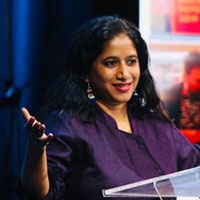Fit for the future: Can we emerge stronger from the COVID-19 crisis?

“Fit for the future: Can we emerge stronger from the COVID-19 crisis?” is reprinted from Alliance magazine.
Civil society was not ready for COVID-19. … Benjamin Bellegy (WINGS), Chris Worman (TechSoup), and Lysa John (CIVICUS) discuss the investments needed in civil society and its philanthropic and technical infrastructure, and the actions we must take to emerge wiser and stronger from the current crisis and to be prepared for crises to come.
Lysa John

It seems ironic that only a few months ago, we were celebrating 2019 as the “Year of People Power” and a mass global uprising against autocratic regimes across the world seemed achievable. At a stroke, we have experienced the abrupt removal of fundamental freedoms that human rights defenders have fought to protect. And yet, civil society across the world has found new ways to respond to the outbreak. Organisations around the world have provided food, health care, and other essential services to those in need. They have shared information, undertaken analyses, and coordinated the actions needed to reinforce accountability and pursue responsive policy outcomes, all at a scale that we haven’t seen in years.
However, the pandemic is forcing us to tackle some glaring distortions in the way we operate as a sector. One such distortion that is painfully visible as a result of the pandemic is the extreme fragility of our support systems. The CIVICUS Monitor points to several alarming trends underlying the measures taken to contain the pandemic including unjustified restrictions on access to information; detention of activists for disseminating critical information; crackdowns on human rights defenders and media outlets; violations of the right to privacy and sweeping emergency powers.
A statement to world leaders supported by over 600 organisations underscores the urgent need to act together to stop governments from using the pandemic as a pretext to restrict civic space. Even where an official proclamation of emergency has been made, fundamental rights such as the right to life and freedom from torture and degrading treatment must still be upheld. This must be accompanied by a systematic effort to design and effect a comprehensive global recovery effort.
For civil society specifically, we need to see more direct investment in organisations of the global south. Four years after the international community committed to increase investments in local organisations, the percentage of official development assistance (ODA) reaching them remains at the same level—less than 1 per cent—so while community organisations are best placed to respond to a complex crisis like the pandemic, the infrastructure required to sustain their intervention remains pitifully inadequate.
Soon after the pandemic was declared, close to 200 civil society organisations signed up to a “Social Security Protocol” developed in line with the ILO’s COVID-19 policy framework. The fact that this list includes only one major international organisation is deeply disturbing. Large, global NGOs must be bolder and adopt the social security measures that we are demanding from governments and businesses. Without this, frontline civil society workers—a majority of whom are women—will be disproportionately affected by the loss of jobs and incomes resulting from cost-cutting measures.
Six years ago a group of leaders put out an open letter to civil society exhorting us to ensure that our primary accountability is “to everyone that is or has been on the losing end of globalisation and inequality and to the generation that will inherit a catastrophic future.” Coming out of this pandemic, we must agree that correcting inequity of access within civil society is a challenge we can no longer ignore.
Benjamin Bellegy

Civil society’s role is critical in reaching communities and providing services governments cannot or will not. Perhaps above all, the third sector might be the only one still able to generate a vision of, and new models for, our societies. The voluntary response to the COVID-19 crisis is spectacular. At a time when we face fundamental questions about a civilisation built on individualism, consumerism, and an outdated idea of progress … beyond much-needed services, civil society can provide hope, vision, and concrete experiences for a future we need to rethink.
The philanthropic response has been impressive, too. Brazil, for instance, has seen a surge in donations to nearly 700 million USD. In China, Yishan has tracked over 4 billion USD in donations, both countries where people tend to rely on the state to address social issues. We have observed pledges and calls to encourage foundations to support their partners by providing unrestricted funding, listening to their needs, spending down, and thinking long-term.
However, I see two downsides to this positive assessment: first, much more could be done with an adequate support system for giving. In countries like India, civil society and philanthropy are struggling to be part of the government’s response because they lack the infrastructure to raise their voice. A consequence of this is that private philanthropic support flows to non-transparent government funds rather than to grassroots organisations that face a severe lack of funding just when their communities need them most.
Second, instead of patting ourselves on the back for our response, we need to engage in a more radical reflection on both the society we want to rebuild after COVID-19, and on the sector we need to achieve that vision. We need a a philanthropy sector that engages in systems change, embraces policy advocacy, leverages financial and non-financial assets. With a strong ecosystem of support able to build trust and transparency, to advocate for enabling policies, and to build bridges with other sectors, the philanthropic response would not only be multiplied financially but also in terms of impact.
This in turn requires funders to realise that real impact can only be achieved as a collective, through connection and collaboration. Once this mindset is in place we might see greater reflection on the need for a strong, shared infrastructure, and more investment, both on the supply and demand side of civil society.
Increasingly we see funders engaging in such reflections. The WINGS global network is engaged in the #LiftUpPhilanthropy campaign to raise awareness of this question and our coming research will propose a methodology to map the support ecosystem and engage funders and stakeholders strengthening it. The support organisations also have a role to play by reinventing themselves, creating a paradigm of collaboration and field thinking, so that the infrastructure becomes a proper ecosystem which gets its resilience from its diversity and interconnections.
This crisis may be a turning point. It has made the interdependence of philanthropic actors and the need for a strong infrastructure obvious. It has shown the need for data, for a voice for them to advocate, and for a collective space to reflect on their role in rebuilding the society we want. Perhaps, paradoxically, the distance the crisis has imposed on us, will reaffirm how interconnected we are and how much more we can achieve as a field than as individual elements.
Chris Worman

Civil society in the broadest sense—people taking care of people whether or not they are institutionalised as NGOs, whether or not they are paid to do it—is performing admirably and to its best ability.
Meanwhile, it is clear that civil society in the more formal sense is struggling. There are dire predictions that many NGOs will disappear. If we are honest with ourselves, this is not surprising. Some of them will disappear and I mourn the disappearance of their aggregated knowledge and community-level trust. On the other hand, grassroots social action seems to be responding admirably well. Most community-based organisations seem to be making do. Others will replace those lost and we may see a more community-based generation of civil society leaders emerge from this crisis.
Many institutionalised NGOs, on the other hand, seem to be responding to the crisis and associated struggles by pointing at philanthropy’s failure to give them more money. Surely some philanthropic actors could be doing more but there was never enough philanthropy to cover all costs for all NGOs all the time and there never will be. Foundation and government aid represents less than 1 per cent of the total economic value of civil society. As Lysa, Benjamin, and others have pointed out, responding to the crisis means pointing out the weaknesses of a system that many like to call civil society, but by which they really mean philanthropically and governmentally supported NGOs. The breakdown of that system, the power, institutional and infrastructure disparities within it are all on perfect display.
While we all work to take care of our communities, we need to talk about the infrastructure we need and begin to build it so that civil society—formal or not—can help humanity prepare for and recover from crises to come. If we can do that, we will have done more than respond, we will have grown.
COVID-19 is—amongst other things—a uniquely digital crisis. Social distancing forced all who could to work from home and use remote services. Those who were able to make the shift are at risk of increased surveillance and data insecurity. While a digitally mature civil society sounds (and is) an enormous concept, it is not unfeasible. Organisations like TechSoup provide digital tools, training, and services globally. There are many more with whom we could partner. There are others working on digital policy, building new tools and types of infrastructure with the sector. Others, like Candid, work to make sense of the data we create.
If the world’s millions of health workers, for instance, had had tools like WorkerConnect, with its combination of notification and reporting functions, when COVID-19 appeared, healthcare providers would have known what to look for and how to prepare based on what others were learning. If they saw symptoms, or had specific needs, they could ave raised them with crisis response coordinators (anonymously, if needed). Media could have had more accurate information. Governments could have had community-level data on spread, nature, and needs. You and your family would have been safer.
We are not unimaginably far from that. Building the digital infrastructure we need (rather than the one we will otherwise get) will take a clear vision of the combined policy, skills, and learning capacities we need, matched with appropriate financial models and support. We need to identify who is best at solving which problems and advocating to get them the support they need.
I once met a sociologist researching the intersection of individual philanthropy and natural disaster. He pointed out that during disaster and shortly after, people exhibit their altruistic best selves for reasons they have difficulty articulating. His research indicated that if you can get people to recognise their changed behaviour you can get them to label it, value it, and compare it to where they had been. If so, this is our moment to change. The crisis has shone a light on behaviour we probably should have been practising anyway. If we do not talk about and evaluate the new versus the old we will not be able to value the difference and we will return to the way things were. We need to identify the difference, have the conversation, and establish some new norms.
As environmental, economic, political, and demographic trends converge, we will face increasingly challenging crises and we will need civil society in its most holistic sense to maintain space and voice for our most vulnerable. This crisis has shown us how much we lack and what we need to build.
Afterword
What if we had been ready for COVID-19? What if we had the infrastructure we needed to respond? There are possibilities for partnership, collaboration, and growth.
We call on civil society and funders alike to consider the support ecosystem for civil society and philanthropy as a fundamental issue going forward; one we can all positively influence and one we all need to best leverage our individual and collective potential.
There are models (Unlocking Philanthropy’s potential; What makes a strong ecosystem of support to philanthropy?) and there is evidence that infrastructure organisations are making a big difference (Promoting an enabling environment for philanthropy and civil society). We know what needs to be done and we can do it. We must do it. Whatever our cause, it is central to our social mission.
Edited by Andrew Milner, associate editor at Alliance magazine
Note from Alliance: This article is an abridged version of an article which has also been published on the WINGS blog site “Philanthropy in Focus.” The full article can be read here.






